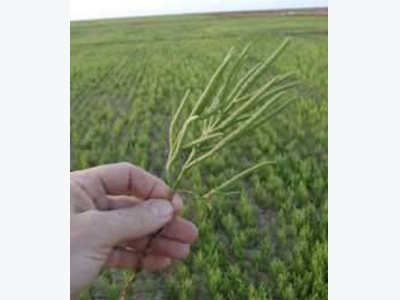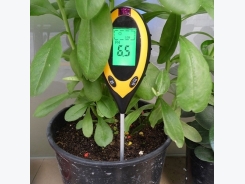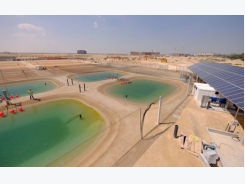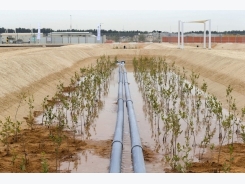Biofuels from Saltwater Crops

A research project will make jet fuel without wasting fresh water or farmland.
A project in the Middle East aims to make jet fuel from saltwater-tolerant crops grown in the desert. Researchers at the Masdar Institute in the United Arab Emirates are starting a two-square-kilometer demonstration farm that will combine fish and shrimp farming with the cultivation of mangrove trees and salicornia, a plant with oil-rich seeds that can be converted into fuel.
The goal is to produce biofuels without taking away land from food crops or using large amounts of fresh water, which are two of the major shortcomings of conventional biofuels, says Scott Kennedy, an associate professor at the Masdar Institute who is leading the project. The project is supported by several major companies: Boeing, Etihad Airways (the national airline of the UAE), and UOP Honeywell, which will supply technology for converting the biomass to chemical precursors and fuels. The Masdar Institute is part of a zero-emissions city being built in Abu Dhabi, the largest emirate in the UAE.
Fuel crop: A field of salicornia, a saltwater-tolerant plant, at a test plot in the north African country of Eritrea.
Kennedy and his colleagues will refine a technique called integrated seawater agriculture. It begins with digging a canal from the sea. That canal delivers water to several stages in the system. First, the researchers pump saltwater into ponds or flow it past cages used for growing shrimp or fish. Ordinarily, such aquaculture is an “environmental disaster,” Kennedy says. The runoff contains large amounts of feces that can cause dangerous algae blooms, for example. But in the Masdar system, the researchers will use that effluent downstream to fertilize salicornia.
The salicornia is grown in saltwater-irrigated fields, and can be harvested like other crops, such as wheat or rice. The runoff from that irrigation, now saltier and still containing some effluent from the fish and shrimp, together with more water from the canal, is next fed to a stretch of planted mangrove trees, which can grow in that saltier water. The mangrove forest provides a barrier, so that none of the polluted water from the fish farm returns to the ocean. The leaves can also be used as food for the fish.
The oil-rich seeds of the salicornia can be pressed using processing similar to that used for other oil seed crops, such as sunflowers. That oil can then be modified by a proprietary UOP Honeywell process that makes it suitable for blending in jet fuel. The rest of the plant can then be further used to produce liquid fuels, or burned to produce steam for electricity generation.
The fish farms provide both a source of income and a source of fertilizer, which reduces overall carbon emissions, since producing and using fertilizer is ordinarily a major source of carbon emissions in biofuels production. The mangrove forest also sequesters carbon dioxide in its root system. Most biofuels are at best carbon neutral, emitting as much carbon dioxide when they’re produced and burned as the biofuel crops take in as they grow. One of the key parts of the Masdar research project is determining just how much carbon can be economically sequestered.
A version of the system has already been demonstrated in the north African country of Eritrea by Carl Hodges, the founder and chairman of the Seawater Foundation. (He’s acting as a special advisor to the Masdar project.) In that project, the salicornia and leaves from the mangroves were used as animal feed, and some of the oil from the seeds was converted to biodiesel. That project ended as a result of political upheaval in that country, Hodges says, but it demonstrated that the integrated approach could work.
The effort to avoid using fresh water and land that’s used for food “should be applauded,” says Mark Schrock, a professor of biological and agricultural engineering at Kansas State University. But he says it will be important to quickly develop a mechanized means of harvesting the salicornia. This could be a challenge because, although it can be harvested with existing equipment, the plant has high salt levels that could damage these machines, says Wayne Coates, a professor at the Office of Arid Land Studies at the University of Arizona.
It will also need to compete with other biofuels crops. Per acre yields of oil are on par with soybeans (which provide additional economic value from non-oil products), but are just one-eighth the yield of palm oil. The saltwater system, however, has the advantage of not requiring expensive land and water, and it produces its own fertilizer. Kennedy says that initial estimates suggest that fuel produced from salicornia could be competitive with petroleum-based fuels, but warns that detailed studies still need to be done.
About Author:
Kevin Bullis Senior Editor, Materials
My reporting as MIT Technology Review’s senior editor for materials has taken me, among other places, to the oil-rich deserts of the Middle East and to China, where mountains are being carved away to build the looming cities.
Growing up, I lived for a time in the Philippines, where I knew people who lit their tiny homes with single lantern batteries or struggled to breathe through the dense diesel fumes of Manila, so I have a feel for the pressing need around the world for both cheap energy and clean energy.
Related news
Tools

Phối trộn thức ăn chăn nuôi

Pha dung dịch thủy canh

Định mức cho tôm ăn

Phối trộn phân bón NPK

Xác định tỷ lệ tôm sống

Chuyển đổi đơn vị phân bón

Xác định công suất sục khí

Chuyển đổi đơn vị tôm

Tính diện tích nhà kính

Tính thể tích ao




 World’s first farm to grow food and fuel…
World’s first farm to grow food and fuel…  Masdar trials desert fish farms and biofuels grown…
Masdar trials desert fish farms and biofuels grown…